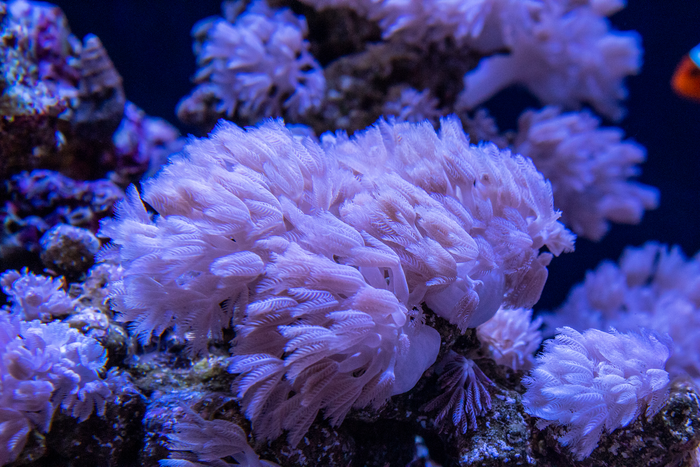Baltimore, MD—New research led by Carnegie’s Yixian Zhen and Minjie Hu reveals how coral cells tag friendly algae before ingesting them, initiating a mutually beneficial relationship. This information could guide next-level coral conservation efforts.

Credit: Photograph by Ed Hirschmugl and Navid Marvi, courtesy of the Carnegie Institution for Science.
Baltimore, MD—New research led by Carnegie’s Yixian Zhen and Minjie Hu reveals how coral cells tag friendly algae before ingesting them, initiating a mutually beneficial relationship. This information could guide next-level coral conservation efforts.
Their work is published in Nature Microbiology.
Corals are marine invertebrates that build large exoskeletons from which reefs are constructed. But this architecture is only possible because of a mutually beneficial relationship between the coral and various species of single-celled algae called dinoflagellates that live inside individual coral cells. These algae convert the Sun’s energy into food using a process called photosynthesis and they share some of the nutrients they produce with their coral hosts.
Coral reefs have great ecological, economic, and aesthetic value. Many communities depend on them for food and tourism. Despite this, human activity is putting strain on these fragile communities. Warming oceans, pollution, and acidification all affect this symbiotic relationship.
“Many corals are particularly sensitive to elevated temperatures,” explained Hu. “As oceans heat up, they lose algae, starve due to the lack of nutrients, and die off, a phenomenon called bleaching, because it leaves the coral skeleton looking ghostly white.”
For several years, teams of Carnegie researchers, including Zheng and Hu, have been elucidating the molecular and cellular mechanisms underpinning coral-algae symbiosis. Understanding these processes could inform strategies to prevent bleaching and promote coral resilience.
In this new study, the researchers—including Carnegie’s Yun Bai and Xiaobin Zheng—deployed sophisticated bioinformatic and molecular biology tools to reveal the early steps of symbiosis, during which the algae are taken up into the coral. They found a molecule called LePin, which the coral secretes. It is concentrated in the mouth of corals, where it may bind to incoming algae, marking them for uptake into coral cells.
“Understanding how corals tell which algae to take up is an important step in gathering information that will help us mitigate coral bleaching,” Zheng said.
LePin is evolutionarily conserved among soft corals, stony corals, and anemones that perform symbiosis with algae, which means that it could be a good target for efforts to genetically engineer at-risk corals to increase their hardiness in the face of temperature increases.
“Gaining a deeper understanding of LePin could enable us to differentiate how some species of coral are better able to identify and take up heat-resistant algae than others,” Zheng explained. “Once isolated, the LePin sequences that are capable of identifying hardier and more heat-resistant algae could be transplanted into vulnerable coral populations to reduce bleaching events.”
In 2020, Zheng was selected as one of 15 scientists awarded a highly competitive grant from the Gordon and Betty Moore Foundation to support research on symbiosis in aquatic systems. She has been building on Carnegie’s long-standing tradition of model organism development to understand the molecular mechanisms of endosymbiosis in coral. These efforts illustrate how modern biomedical techniques can be applied to solving urgent ecological challenges—a research priority for Carnegie.
__________________
This work was supported by the Gordon and Betty Moore Foundation.
The Carnegie Institution for Science (carnegiescience.edu) is a private, nonprofit organization headquartered in Washington, D.C., with three research divisions on both coasts. Since its founding in 1902, the Carnegie Institution has been a pioneering force in basic scientific research. Carnegie scientists are leaders in the life and environmental sciences, Earth and planetary science, and astronomy and astrophysics.
Journal
Nature Microbiology
DOI
10.1038/s41564-023-01397-9
Method of Research
Experimental study
Subject of Research
Animals
Article Title
‘Coral–algal endosymbiosis characterized using RNAi and single-cell RNA-seq
Article Publication Date
22-May-2023




